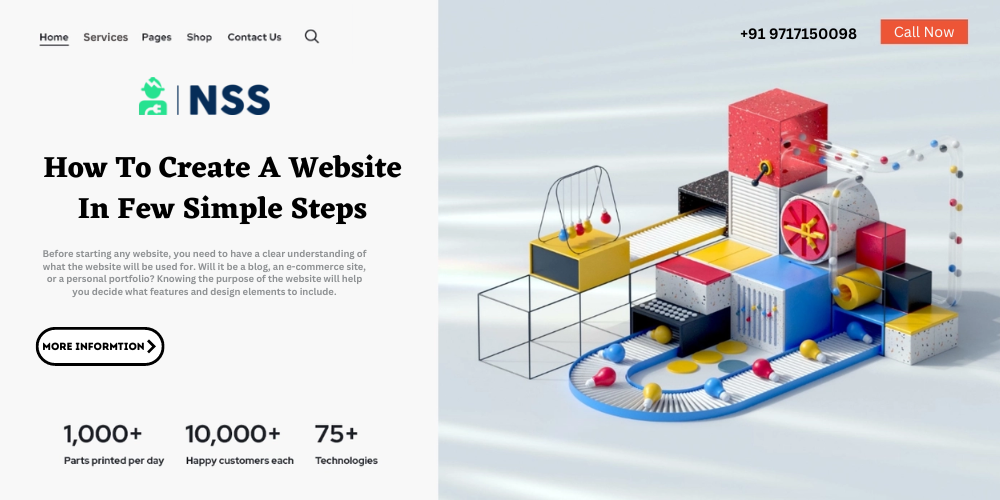
Introduction
Importance Of Having A Website
In today's digital age, a website has become essential for businesses, individuals, and organizations. A website helps establish an online presence and allows people to find and connect with you quickly. It serves as a platform to showcase your products, services, or talents to the world and can even help you attract new customers or clients.
Creating A Website Is Easier Than Most People Think (How To Make A Website)
While creating a website may seem daunting initially, it is easier than most people think. Thanks to the numerous website builders and online resources available today, anyone can create a website without needing any technical skills or experience.
Steps To Follow To Create A Website (How To Build A Website)
If you're thinking of creating a website but don't know where to start, don't worry. In this article, we will guide you through the steps you need to follow to make a website that looks professional and functions effectively. From choosing a platform to registering a domain name, designing your website, and optimizing it for search engines, we will cover all the essential steps to help you create a website to help you achieve your goals.
So whether you're looking to launch a new business, showcase your portfolio, or create an online presence for your non-profit organization, creating a website is easier than you think. Let's get started!
Choose A Platform
Introduce Different Website Builders Available
When it comes to how to make a website, one of the first decisions you'll need to make is choosing a platform or website builder to use. Numerous options are available, each with its pros and cons.
Some popular website builders include WordPress (WordPress how to build a website), Wix, Squarespace, Shopify, and Weebly. WordPress is one of the most widely used website builders known for its flexibility and customization options. Wix is another popular choice, offering easy drag-and-drop functionality and a wide range of templates.
Squarespace is known for its sleek and modern designs, while Shopify is designed specifically for e-commerce websites. On the other hand, Weebly is an excellent choice for those new to website building, thanks to its user-friendly interface.
Pros And Cons Of Each Platform
Each website builder has its own set of advantages and disadvantages. For example, while WordPress offers unparalleled flexibility and customization options, it may be overwhelming for beginners. Conversely, Wix is incredibly user-friendly but may not provide as much flexibility as WordPress. Shopify is an excellent choice for those looking to create an online store, but it may not be the best fit for other websites.
Recommend A Platform Based On The User's Needs
When choosing a website builder, it's essential to consider your needs and goals. Are you looking to create a simple blog or need a robust e-commerce platform? Do you have experience with website building, or are you new to the process? Considering these factors, you can choose a website builder that best suits your needs.
In summary, numerous website builders are available, each with its advantages and disadvantages. When choosing a platform, consider your needs and goals, and choose a website builder offering the required features and functionality.
Register a Domain Name
When creating a website, one of the essential steps is registering a domain name.
What A Domain Name Is
A domain name is an address that people use to access your website, such as "www.digitalbrandingstudio.com." Choosing a domain name that is easy to remember and relevant to your brand or business is essential.
Tips For Choosing A Good Domain Name
To choose a good domain name, it's essential to consider the following tips:
- Keep it short and straightforward: A more temporary domain name is easier to remember and type, making it more user-friendly.
- Make it relevant: Your domain name should reflect the purpose or content of your website. For example, if you're creating a website for a bakery, a domain name like "www.deliciouscakes.com" would be more relevant than "www.bakerywebsite.com."
- Avoid numbers and special characters: Using numbers or special symbols in your domain name can make it harder to remember and type, so it's best to avoid them if possible.
- Consider the extension: The extension is the suffix at the end of your domain name, such as ".com," ".org," or ".net." It's best to choose a popular extension like ".com" as it's easier for people to remember.
Once you've chosen a domain name, you'll need to register it. This process involves selecting a domain registrar, a company that sells and manages domain names. Some popular domain registrars include GoDaddy, Namecheap, and Bluehost.
Register Your Domain Name At an affordable Price
The Process Of Registering A Domain Name
To register a domain name, search for the domain name you want on the registrar's website. If the domain name is available, you can proceed with the registration process, which typically involves providing your contact information and paying a fee. Once you've registered your domain name, it's yours as long as you renew it yearly.
In summary, registering a domain name is essential in creating a website. Choosing a relevant and user-friendly domain name and registering it with a reputable domain registrar ensures your website is easily accessible to your audience.
Set up Hosting
After registering your domain name, the next step in creating a website is setting up hosting.
What Web Hosting Is
Web hosting is a service that allows your website to be accessible online. Essentially, web hosting companies provide servers where your website's files are stored, and users can access your website through these servers.
Hosting Providers Based On The User's Needs
Numerous web hosting providers are available, each with its features and pricing. Some popular options include Hostinger, Bluehost, HostGator, SiteGround, and DreamHost. When choosing a web hosting provider, it's essential to consider your needs and budget. I recommend selecting HostGator as the best and most budget-friendly hosting option.
Choose Most Secure and Affordable Hosting - Hostinger (Click Here)
For example, a shared hosting plan may be sufficient for starting with a small website. This plan involves sharing server resources with other websites, which can be more affordable but may also result in slower load times. On the other hand, if you have a more extensive website or require more resources, a dedicated hosting plan may be a better fit. This type of plan involves having a dedicated server for your website, which can be more expensive but can also provide faster load times and more resources.
The Process Of Setting Up Hosting
To set up hosting, sign up for a hosting plan with your chosen provider. This typically involves selecting a plan, providing your contact and billing information, and choosing a domain name (if you haven't already registered one). Once you've completed the setup process, you'll be provided with login credentials to access your hosting account.
In summary, hosting is an essential step in creating a website. Choosing a hosting provider that meets your needs and budget ensures your website is accessible and runs smoothly for your audience.
Design The Website
When creating a website, designing it well is critical to attracting and retaining visitors.
Importance Of A Good Website Design
A good website design looks appealing and makes it easy for visitors to navigate and find what they're looking for.
Here Are Some Tips For Designing A Website That Is Both Attractive And Functional:
- Choose a website template or theme: Many website builders offer pre-designed templates or themes that you can use as a starting point for your website. These templates are typically customizable and can help you create a professional-looking website even with limited design experience.
- Customize your website: Once you've selected a template or theme, you can customize it to fit your brand or business. This may involve changing the colors, fonts, and images to reflect your brand's personality better.
- Make it mobile-friendly: With more and more people accessing websites on their mobile devices, ensuring your website is mobile-friendly is essential. This means using responsive design, which allows your website to adjust to different screen sizes.
- Simplify navigation: A straightforward and easy-to-use navigation menu is essential for helping visitors find what they're looking for on your website. Make sure your menu is easy to read and logically organized.
- Use high-quality images and graphics: High-quality images and pictures can help make your website more visually appealing. However, ensuring the images are optimized for web use is essential to prevent slow load times.
- Test your design: Once you've designed your website, test it on different devices and browsers to ensure it looks and functions correctly. You can also ask for feedback from friends or colleagues to get an outside perspective.
In summary, website design is essential in creating a successful online presence. By choosing a template or theme, customizing your website, and following best practices for website design, you can create an attractive and functional website for your audience.
Add Content
Adding content is crucial in creating a website that engages and informs visitors. Good website content helps to establish your brand or business's identity, builds trust with your audience, and can drive traffic to your website. Here are some tips for creating compelling website content:
- Know your audience: Understanding your target audience is essential for creating content that resonates with them. Consider their interests, needs, and pain points, and tailor your content accordingly.
- Use clear and concise language: Writing clearly and concisely can help ensure your content is easy to understand and engaging for your audience. Use short sentences and paragraphs, and avoid jargon or technical language that may be unfamiliar to your readers.
- Optimize for search engines: Optimizing your content for search engines can help increase visibility and drive traffic to your website. This involves using relevant keywords, meta descriptions, and headers.
- Use visuals: Incorporating visuals, such as images, videos, or infographics, can help break up text and make your content more engaging for visitors.
- Consistent: Consistency in tone, style, and branding can help establish your website's identity and build trust with your audience. Use a consistent manner and style throughout your website, and ensure that your branding is clear and prominent.
Types Of Website Content Can Include:
- Home page: This is often the visitors' first page on your website. It should be clear and concise and provide an overview of your brand or business.
- About Us: This page should provide more information about your brand or business, including its history, values, and mission.
- Products or Services: This page should showcase your offerings and provide detailed information.
- Blog: A blog is a great way to create regular content for your website and establish yourself as an expert in your field.
The Process Of Adding Content To Their Website
To add content to your website, log in to your website builder's dashboard and select the page you want to edit. You can then add text, images, videos, and other content using the editor tools provided. Once you've added your content, preview it to ensure it looks and functions correctly before publishing it live.
In summary, adding effective website content is essential in creating a website that engages and informs visitors. By understanding your audience, using clear language, optimizing for search engines, using visuals, and being consistent in your branding, you can create content that resonates with your audience and drives traffic to your website.
Optimize for Search Engines
What Search Engine Optimization (SEO) Is
Search engine optimization (SEO) improves a website's visibility and ranking in search engine results pages (SERPs). Optimizing your website for search engines can help increase organic traffic, drive conversions, and establish your brand's credibility.
Tips For Optimizing A Website For Search Engines
Here are some tips for optimizing your website for search engines:
- Conduct keyword research: Keyword research involves identifying the search terms and phrases your target audience uses to find information related to your brand or business. Once you have recognized these keywords, you can optimize your website's content and metadata to include them.
- Use meta descriptions: A meta description summarizes your website's content in search engine results. It's important to write compelling and relevant meta descriptions that accurately reflect the content of your website and encourage users to click through to your site.
- Optimize your website's structure: A well-structured website can help search engines understand and crawl your content more easily. Use clear and descriptive headings, organize your content into categories, and ensure your website's navigation is user-friendly.
- Use internal and external links: Including links to other pages on your website and to external websites can help improve your website's credibility and authority in the eyes of search engines.
- Use alt tags for images: Including descriptive alt tags for your website's ideas can help improve your website's accessibility and make it easier for search engines to understand your content.
- Ensure your website is mobile-friendly: With more users accessing the internet via mobile devices, it's essential to ensure your website is mobile-friendly. A mobile-friendly website provides a better user experience and can improve your website's ranking in mobile search results.
- Monitor your website's performance: Use analytics tools to monitor your website's performance, including traffic, bounce, and conversion rates. This information can help you identify areas for improvement and adjust your SEO strategy accordingly.
Optimizing your website for search engines is essential in creating a website that drives traffic and conversions and establishes your brand's credibility. By conducting keyword research, using meta descriptions, optimizing your website's structure, using internal and external links, using alt tags for images, ensuring your website is mobile-friendly, and monitoring your website's performance, you can improve your website's visibility and ranking in search engine results pages.
Launch The Website
Launching your website is the final step in the website creation process.
Here Are Some Tips For Launching Your Website Successfully:
- Test your website thoroughly: Before launching your website, it's essential to test it thoroughly to ensure that everything is working correctly. Test your website on different devices and browsers, and check for broken links, missing images, and other issues.
- Troubleshoot any issues: If you encounter any problems during testing, troubleshoot them before launching your website. Typical topics may include slow loading times, broken links, or problems with website functionality.
- Choose a launch date: Once you have tested and troubleshoot your website, choose a date. Make sure to inform your audience and customers about the launch date.
- Launch your website: On the launch date, make your website live. This typically involves updating your domain's DNS records to point to your hosting provider's servers.
- Monitor your website: After launching your website, monitor it regularly to ensure everything works correctly. Check your website's analytics to track traffic, engagement, and other metrics.
- Update your website regularly: To keep it relevant and engaging, update it regularly with new content, features, and functionality. This may include adding recent blog posts, updating product pages, or adding new features to your website.
- Back up your website regularly: To protect your website from data loss or security breaches, back up your website regularly. This ensures you can quickly restore your website in case of a problem.
In summary, launching your website involves testing and troubleshooting your website, choosing a launch date, making your website live, monitoring your website, updating your website regularly, and backing up your website. By following these tips, you can successfully launch your website and ensure it continues to serve your audience and customers effectively.
Conclusion
In conclusion, creating a website can seem daunting, but it is a manageable process with the right tools and guidance. Here are the key steps to follow when creating a website:
- Choose a website-building platform that meets your needs.
- Register a domain name that is memorable and easy to remember.
- Set up hosting with a reliable provider.
- Design your website with an attractive and functional layout.
- Add high-quality content to your website that engages and informs your audience.
- Optimize your website for search engines to increase visibility and traffic.
- Launch your website and continue to monitor and update it regularly.
A website is essential for any individual or business looking to establish an online presence. With the right tools and guidance, anyone can create a website that meets their needs and goals. We encourage users to take the first step in creating their website today and begin enjoying the benefits of a solid online presence.
Popular Services
- MacBook Battery Replacement Cost
- HP Printer Repair in Delhi NCR
- Dell Laptop Repair
- HP Laptop Repair
- Samsung Laptop Repair
- Lenovo Laptop Repair
- MacBook Repair
- Acer Laptop Repair
- Sony Vaio Laptop Repair
- Microsoft Surface Repair
- Asus Laptop Repair
- MSI Laptop Repair
- Fujitsu Laptop Repair
- Toshiba Laptop Repair
- HP Printer Repair Pune
- Microsoft Surface Battery Replacement
- Microsoft Surface Screen Replacement




